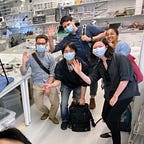As part of the Fitbit Redesign sprint, our first activity after trying out our devices was to deconstruct them to better understand how they function from both digital and physical points of view.
Digital Deconstruction
Front End
To begin, the team deconstructed the mobile app and web portal by screens and features to uncover functionalities, data visualization techniques, and interaction modes. Shin deconstructed the Fitbit app when linked to the Ace 3, which is intended for children and their parents as separate users of the same device. The app home screen is categorized by activity that users track. The user’s achievement in each activity is displayed by a progress circle.
Activity data is shown by statistical charts and numbers. The visualization flow is common as it starts from an overall view to details by tapping or swiping screens. Most of the charts are static and have no dynamic interactions.
In the setting, it’s interesting that Fitbit allows users to manage privacy by item, not as a whole together. On the other hand, inclusivity or diversity of users could be more incorporated into design such as gender identity.
Back End
Alongside deconstructing the front end, the API data flow was mapped based on information from the Fitbit developer site and our best guesses. It is assumed that data is collected by sensors in a device and sent to be stored in Google Cloud Healthcare Data Engine.
The data can be accessed and managed via Fitbit API. For example, the device API seems to be structured by four main categories, body data, environmental data, device data and behavioral data. Behavioral data can be calculated based on raw data such as that of the body and the environment.
Physical Teardown
The intent of deconstructing the physical system was to identify key components that correspond to unique device features and consider the materials and processes used to make the components and assembly as a whole. After considerable pulling and prying the screen and back cover were removed to allow for easier disassembly.
With help from prior iFixit repair guides, articles about the Fitbit assembly, and our prior experiences in manufacturing, we determined the core parts that comprise the assembly are as follows:
- Li-ion Battery
- OLED Display
- Haptic Module
- IR Sensor and Receiver
- ARM CPU
- Stainless Steel and Aluminum Housings
- Pogo Pin Charging
- Stainless Steel Brackets
- Torx Screws
- Silicone Bands
Our complete teardown of the Luxe model can be found on iFixit. Overall, the Luxe and Charge 5 models have simple assemblies and few individual components. The majority of functions are embedded in the PCB.
Next we continue to Preconstruction, a phase in which we build a design plan and research how we would create a Fitbit-like system.
